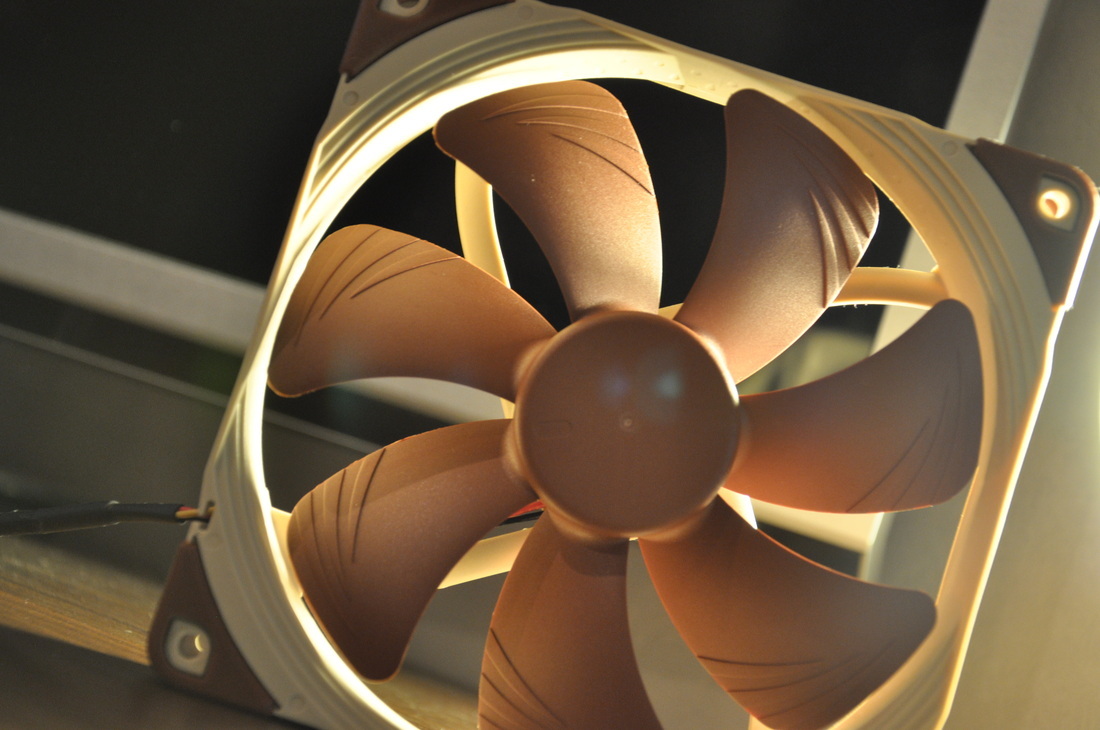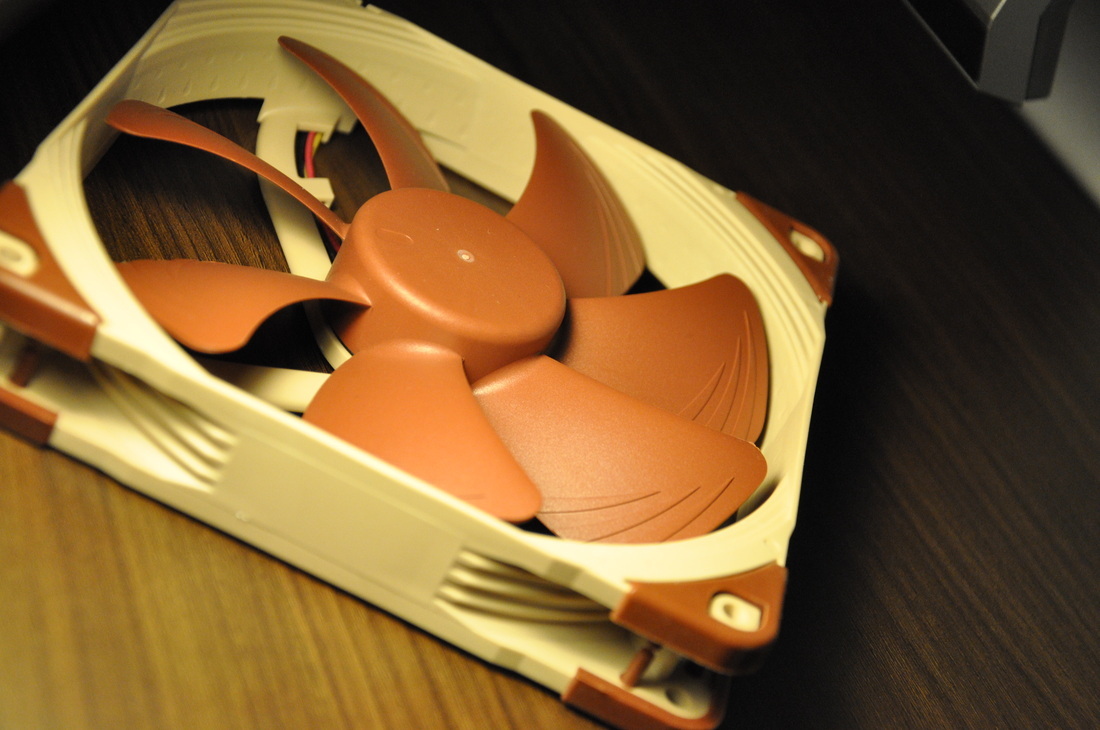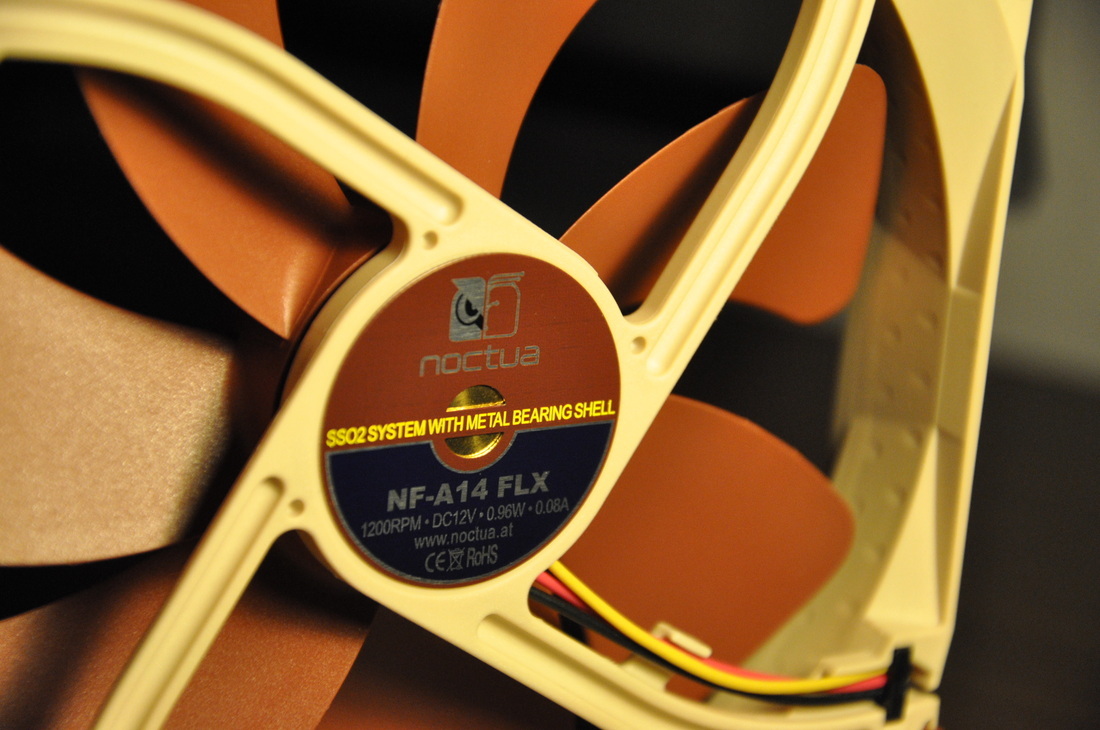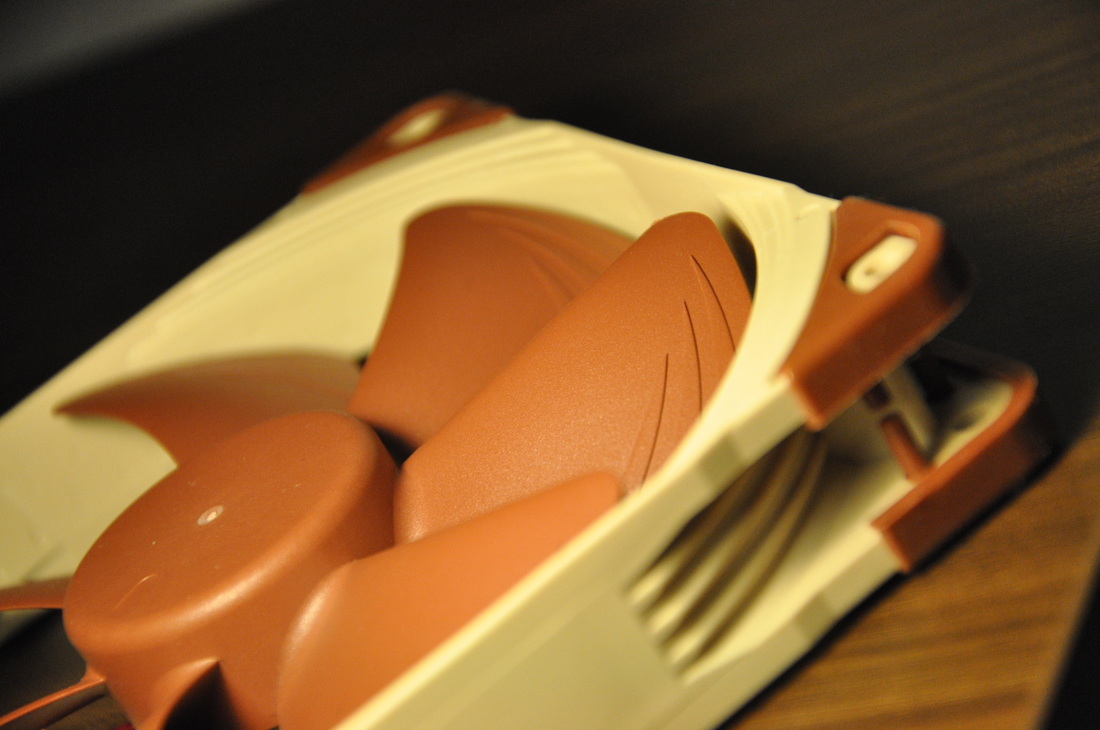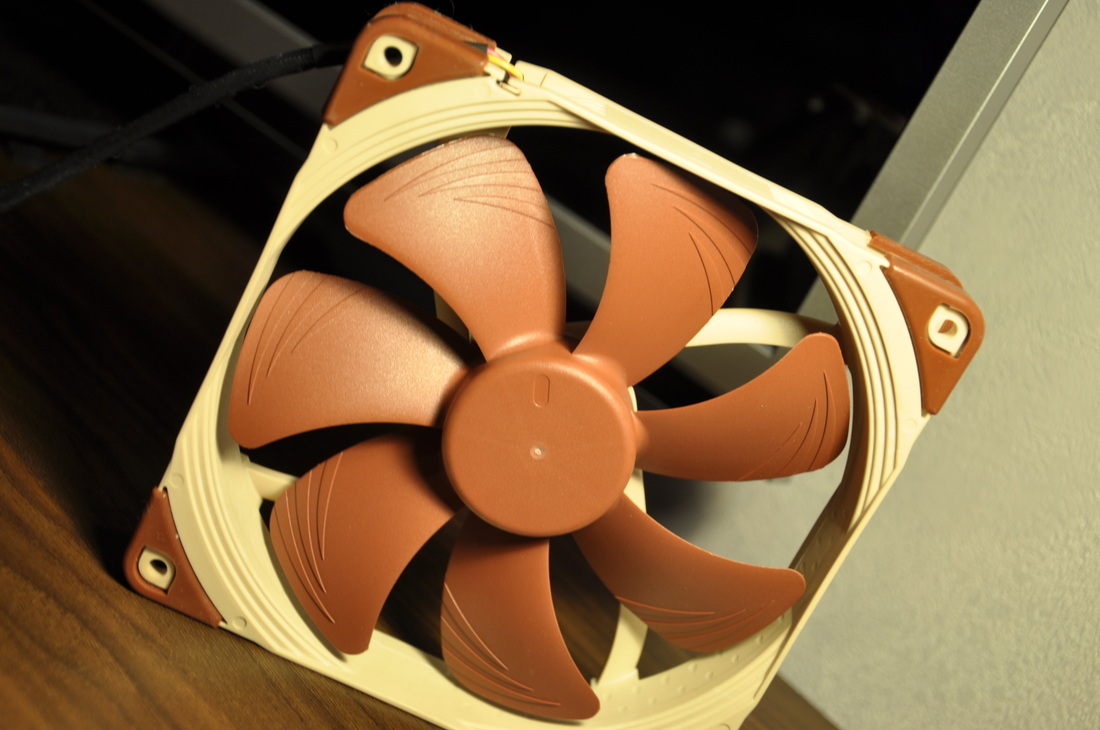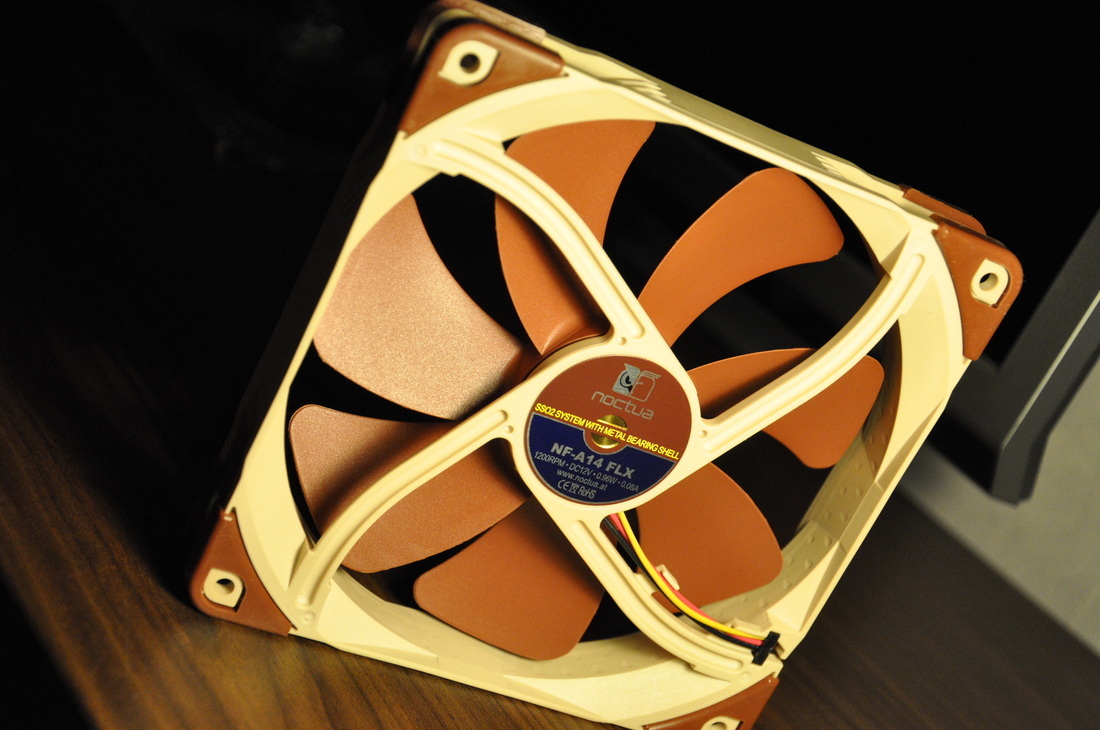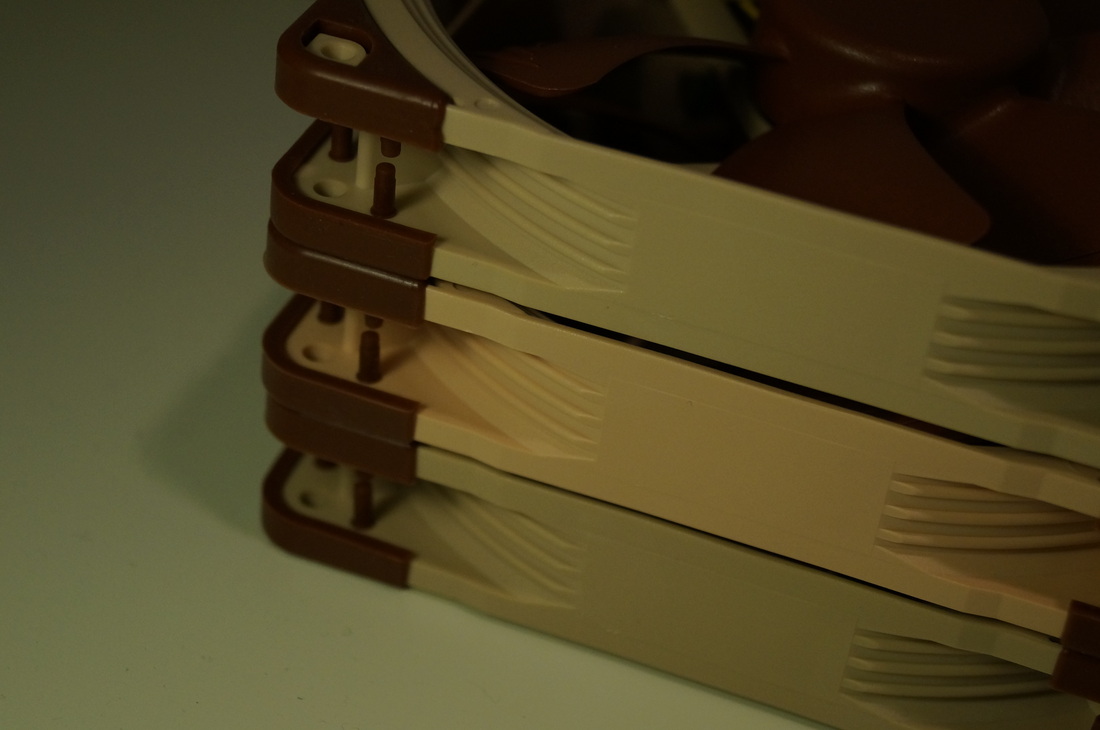After experience with both the NF-A14 FLX/ULN and the NF-A15 PWM, this is the one thing we wanted to see come together from both of them.
Here's the spec: Max RPM Max Airflow (m3/h) Noise (dB(A)) Static Pressure (mmH2O) | Without L.N.A 1500 140.2 24.6 2.08 | With L.N.A 1200 115.5 19.2 1.51 |
Design:
Due to the fact we have already reviewed the NF-A14 FLX & ULN variants, we are going to re-use the photo's form their review along with the sections of the design that are the same. If you have already read our review on those then head down to the performance section!
As general practice Noctua provides a 20cm sleeved cable, wired to the fan, if this is too short they also supply a 30cm sleeved extension cable as well. In my opinion the sleeving of the cables is the highest quality I have ever come across, it has a waxy feel too it and does not feel cheap by any stretch of the imagination. It also does not separate when squashed. The sleeving however finishes when it meets the fan and does not continue all the way through to the motor, although it is like this on every fan to my knowledge, I feel that Noctua have the potential to design some way of integrating the cables a little better in this respect.
As general practice Noctua provides a 20cm sleeved cable, wired to the fan, if this is too short they also supply a 30cm sleeved extension cable as well. In my opinion the sleeving of the cables is the highest quality I have ever come across, it has a waxy feel too it and does not feel cheap by any stretch of the imagination. It also does not separate when squashed. The sleeving however finishes when it meets the fan and does not continue all the way through to the motor, although it is like this on every fan to my knowledge, I feel that Noctua have the potential to design some way of integrating the cables a little better in this respect.
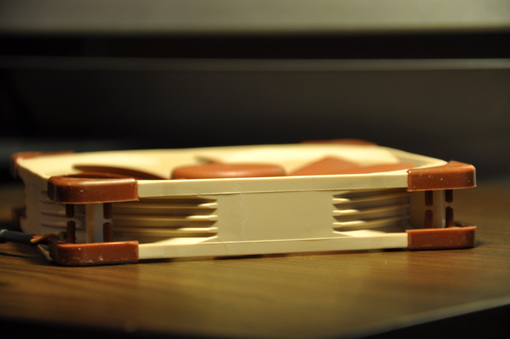
On all 4 corners on each side of the fan we have the integrated anti- vibration pads first seen on the NF-F12, I did and still do to this day feel that this for some reason is my favourite feature out of every fan I have worked with, I don’t know why but I feel that these while being perfect for their job, give the fan a little bit more of a ‘premium’ look that easily detracts from the colour scheme. Using these in conjunction with the anti-vibration mounts is definitely a cool combo to use.
At the corners again, moving in from the pads we see the stepped inlet design, another feature we first saw on the NF-F12, for future notice we will see a lot of these designs further into the review. This design is said to help direct the air into the fan in a more efficient manner. While I can not prove if this is true or not I can definitely say that just like the anti-vibration pads, these make the fan LOOK good.
| Down the insides of the chassis we see the inner surface micro-structures (see the previous paragraph for where we saw these last). Essentially this is designed to create a kind of air buffer between the fan blades and chassis lowering noise from the blades. I guess it speaks for its self when we look at the performance later on. |
The Above 3 create what is known as the AAO (Advanced Acoustic Operation) frame, from this I believe that we will be seeing these integrated a lot more in the future which I am happy about.
Moving on from that we have a NEW feature with this new range. It is called the flow acceleration channels and basically what they are is another feature that helps direct the airflow in a manner that reduces the noise produced while even speeding the air up through the fan. Now the shape of the blades is very curved, something I have never really liked in a fan, I am more into fans with sharp powerful looking blades. These channels however add that little extra touch that give it a bit of that feel to it.
Moving on from that we have a NEW feature with this new range. It is called the flow acceleration channels and basically what they are is another feature that helps direct the airflow in a manner that reduces the noise produced while even speeding the air up through the fan. Now the shape of the blades is very curved, something I have never really liked in a fan, I am more into fans with sharp powerful looking blades. These channels however add that little extra touch that give it a bit of that feel to it.
| Putting all of that to the side though and focusing on the main piece of this fan, the heart of it essentially, the motor and bearing unit. On this product we have the second revision of the self stabilising oil-pressure bearings by Noctua, these are expensive bearings compared to what most competitors use and it is reflected in the performance. To add to this we also have the bearings are surrounded in a brass shell to help performance in the long term. We also find the custom PWM chip on board which is the one thing we previously felt was missing from the A14 that the A15 had. The overall chassis and build quality is to a standard I never seen on any competitor fans. The chassis does not bend at all and feels very secure. |
| A final note to the design is that the sample we received did actually resemble that of the older colours as the chassis was slightly pinker than every other fan that we have reviewed from Noctua lately. This may just be because it is a review sample however and so I am not dwelling on it. Especially as it is not the first A14 fan variant and the other two were fine. |
Performance:
Just like with the FLX version, while running at 12v the fan noise is noticeable but still quiet. Also due to the technology put into the fan and the fact it is a 140mm fan, the noise produced is a nice low hum that disappears quickly into the background noise.
At full speed the fan does produce quite a lot of airflow and a really high static pressure given that the fan is a 140mm rather than a 120.
This all being said, my absolute favourite reason for this fan is that when you use the fan speed reducer, this fan goes completely silent which then coupled with the fact is has PWM functionality means that you end up with a fan that is perfect for any system AND will never become noticeable at any point.
At full speed the fan does produce quite a lot of airflow and a really high static pressure given that the fan is a 140mm rather than a 120.
This all being said, my absolute favourite reason for this fan is that when you use the fan speed reducer, this fan goes completely silent which then coupled with the fact is has PWM functionality means that you end up with a fan that is perfect for any system AND will never become noticeable at any point.
Conclusion:
When the A14 was first released it only came in the FLX and ULN variants as PWM functionality is generally prioritised in heatsink fans and the A15 design was the fan to feature and be designed for this. I personally wasn't that much of a fan of this and really wanted to see them combine together to create an amazing fan. This has been achieved.
The NF-A14 in my eyes has been the perfect successor to the P14 along with with the A15. If you are looking for a solidly built, quiet high performing 140mm fan then the A14 PWM fan is definitely a great choice to go with. Just like the ULN and FLX variants this fan has received our SILVER award and definitely deserves it but due to it being the exact product we wanted to see from Noctua it has also received our EDITORS CHOICE award as well.
For anyone looking to upgrade their fans on their 140mm heatsink/ radiator this is a perfect choice!
The NF-A14 in my eyes has been the perfect successor to the P14 along with with the A15. If you are looking for a solidly built, quiet high performing 140mm fan then the A14 PWM fan is definitely a great choice to go with. Just like the ULN and FLX variants this fan has received our SILVER award and definitely deserves it but due to it being the exact product we wanted to see from Noctua it has also received our EDITORS CHOICE award as well.
For anyone looking to upgrade their fans on their 140mm heatsink/ radiator this is a perfect choice!
Verdict:
Rating- 9/10
Value- 8/10
Value- 8/10
